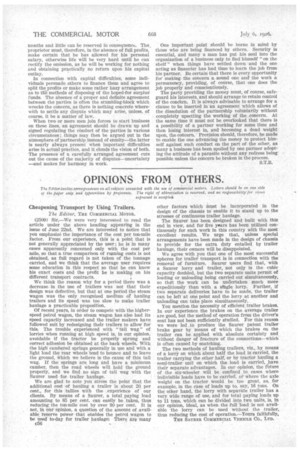OPINIONS FROM OTHERS.
Page 46

If you've noticed an error in this article please click here to report it so we can fix it.
The Editoi-invites correspondence on all subjects connected with the use of commercial motors. Letters should be on one side of the paper only and typewritten by preference. The right of abbreviation is reserved, and no responsibititylor views expressed is accepte4
Cheapening Transport by Using Trailers.
27te Editor, THE COMMERCIAL MOTOR.
(2509) Sir,—We were very interested to read the article under the above heading appearing in the issue of June 22nd. We are interested to notice that you emphasize the importance of the cost per ton-mile factor. From our experience, this is a point that is not generally appreciated by the user; he is in many eases apparently concerned only with the cost per mile, so that a true comparison of running costs is not obtained, as full regard is not taken of the tonnage carried, and we think that the average user requires some education in this respect so that he can know his exact costs and the profit he is making on his different transport contracts.
We think the reason why for a period there was a decrease in the use of trailers was not that their design was defective, but that at one period the steam wagon was the only recognized medium of hauling trailers and its speed was too slow to make trailer haulage a practicable proposition.
Of recent years, in order to compete with the higherspeed petrol wagon, the steam wagon has also had its speed capacity increased and the trailer makers have followed suit by redesigning their trailers to allow for this. The trouble experienced with "tail wag" of lorries when running at high speed is, in our opinion, avoidable if the tractor be properly sprung and correct adhesion be obtained at the back wheels. With the high' cambered springs generally in use and with a light load the rear wheels -tend to bounce and to leave the ground, Which we believe is the cause of this tail wag. If the springs are long and have a minimum camber, then the road wheels will hold the ground properly, and we find no sign of tail wag with the Saurer used for trailer haulage.
We are glad to note you stress the point that the additional cost of hauling a trailer is about 20 per cent., for this tallies with the experience of our clients. By means of a Sauer, a total paying load amounting to 85 per cent, can easily be taken, thus reducing the ton-mile cost by over 30 per cent. It is not, in -our opinion, a question of the amount of available reserve power that enables the petrol wagon to be used to-day for trailer haulage; There are Many
c56 other factors which naust be incorporated in the design of the chassis to enable it to stand up to the stresses of continuous trailer haulage.
The Saurer has been designed and built with this end in view, and for five ycars has been utilized continuously for such work in this country with the most excellent results. We urge that, unless special arrangements have been made in the design of chassis to provide for the extra duty entailed by trailer haulage, their owners will be disappointed.
We agree with you that one of the most successful spheres for trailer transport is in connection with the removal of furniture. Saurer users find that, with a Saurer lorry and trailer, not only is the cubic capacity doubled, but the two separate units permit of loading or unloading being carried out simultaneously, so that the work can be undertaken much more expeditiously than with a single lorry. Further, if two separate deliveries have to be made, the trailer can be left at one point and the lorry at another and unloading can take place simultaneously.
You mention the necessity of efficient trailer brakes. In our experience the brakes on the average trailer are good, but the method of operation from the driver's seat has not been sufficiently studied. For this reason we were led to produce the Saurer patent trailer brake gear by means of which the brakes on the trailer can be applied with absolute certainty and without danger of fracture of the connections—which is often caused by snatching.
The two methods of hauling trailers, viz., by means of a lorry on which about half the load is carried, the trailer carrying the other half, or by tractor hauling a semi-trailer unit on which the load is carried, have their separate advantages. In our opinion, the future of the six-wheeler will 1?e confined to cases where indivisible loads have to be carried, or where the axle weight on the tractor would be too great, as, for example, in the case of loads up to, say, 16 tons. On the other hand, the lorry with separate trailer has a very wide range of use, and for total paying loads up to 11 tons, which can be divided into two units, is, in our opinion, ideal, as when the full load is not available the lorry can be used without the trailer, thus reducing the cost of operation.—Yours faithfully,
THE SAT:RER COMMERCIAL VEHICLE CO., LTD.
















































